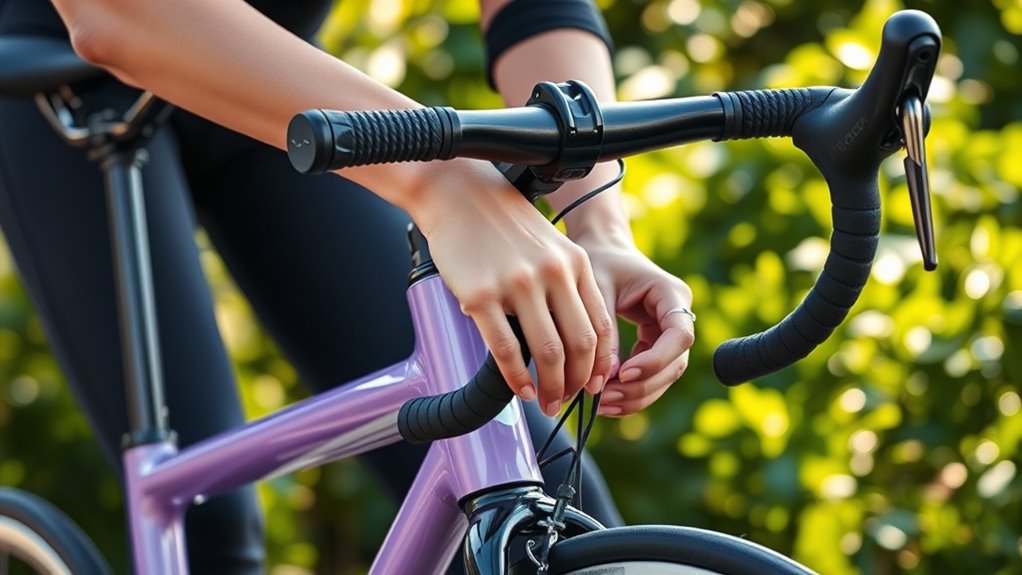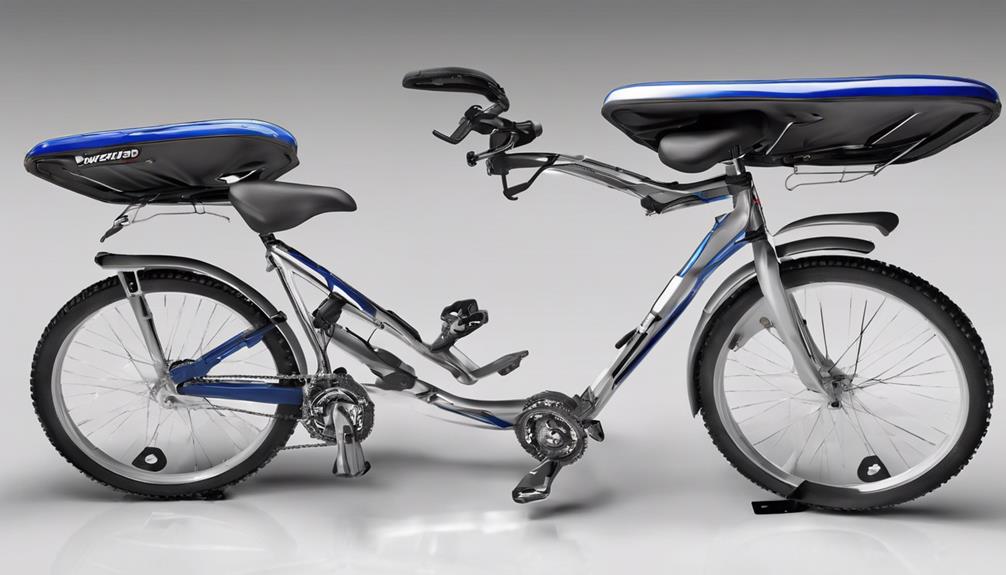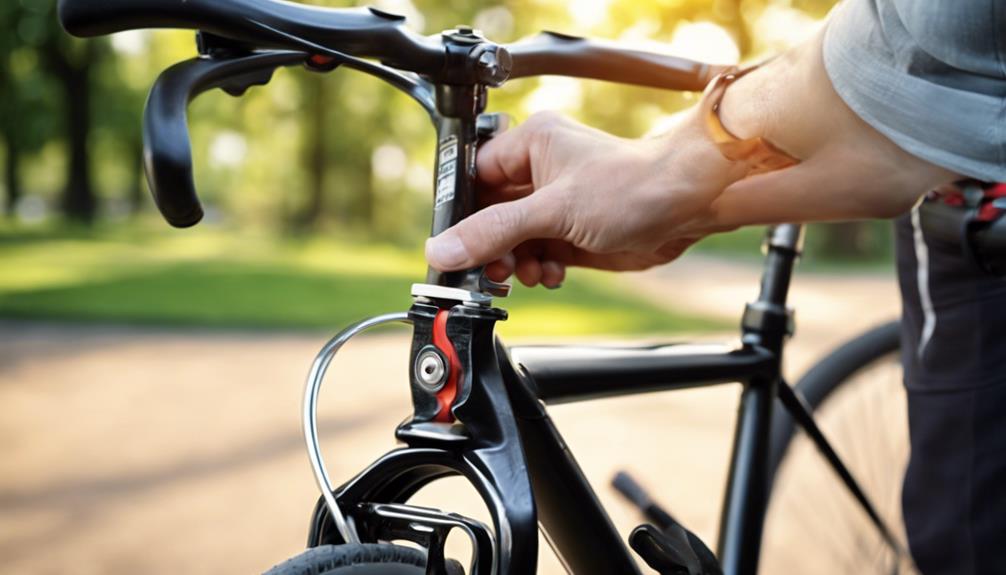To get an ideal bike fit, you should consider your wider hips, shorter limbs, and spinal curvature. Adjust saddle width, tilt, and fore/aft position to match your body, while handlebar width and stem length improve control and comfort. Selecting the right crank length and customizing your bike’s geometry helps prevent discomfort and injury. Exploring ergonomic accessories and expert fitting guarantees your bike suits your unique shape. Keep exploring to discover how each adjustment can elevate your cycling experience.
Key Takeaways
- Adjust saddle width and fore/aft position based on sit bone measurements to accommodate wider hips and improve comfort.
- Choose handlebar width and stem length that match shoulder width and torso length for better control and reduced strain.
- Select shorter crank arms (155-165mm) to optimize pedaling efficiency for women with shorter legs and inseams.
- Incorporate riser handlebars and higher head tubes to support neutral spinal alignment and reduce neck and back tension.
- Work with professionals to customize saddle tilt, height, and handlebar reach, considering spinal curvature and pelvic anatomy for optimal fit.
Understanding Female Body Geometry and Its Impact on Bike Fit
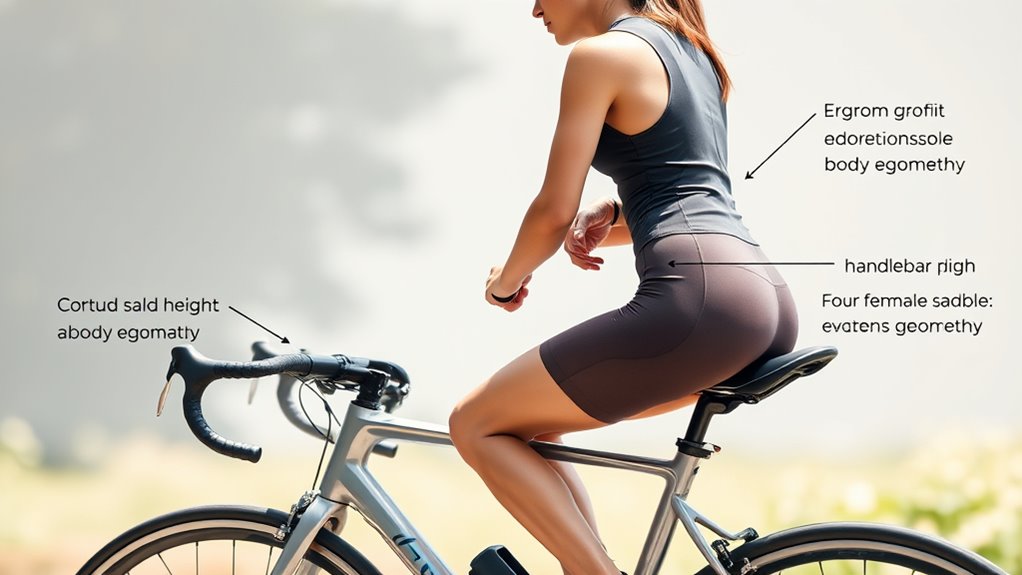
Understanding female body geometry is crucial for achieving an ideal bike fit, as women’s anatomical differences considerably influence comfort and performance. Women generally have a shorter torso-to-leg ratio, making saddle-to-handlebar reach more challenging. You may need shorter stems—often 10-20mm less—to prevent overextension and guarantee a comfortable reach.
Additionally, shorter top tubes help reduce hip angle strain, improving comfort during rides. Your spinal curvature, which tends to be more concave in women, requires careful handlebar positioning; riser bars with 15-30mm rise can help maintain a neutral spine.
Wider hips alter pelvic rotation and knee tracking, so narrower handlebars and precise saddle fore/aft adjustments are essential. Limb proportions, especially shorter femurs, influence crank length and saddle setup, all of which are critical for optimizing your bike fit.
Selecting the Right Saddle for Comfort and Support
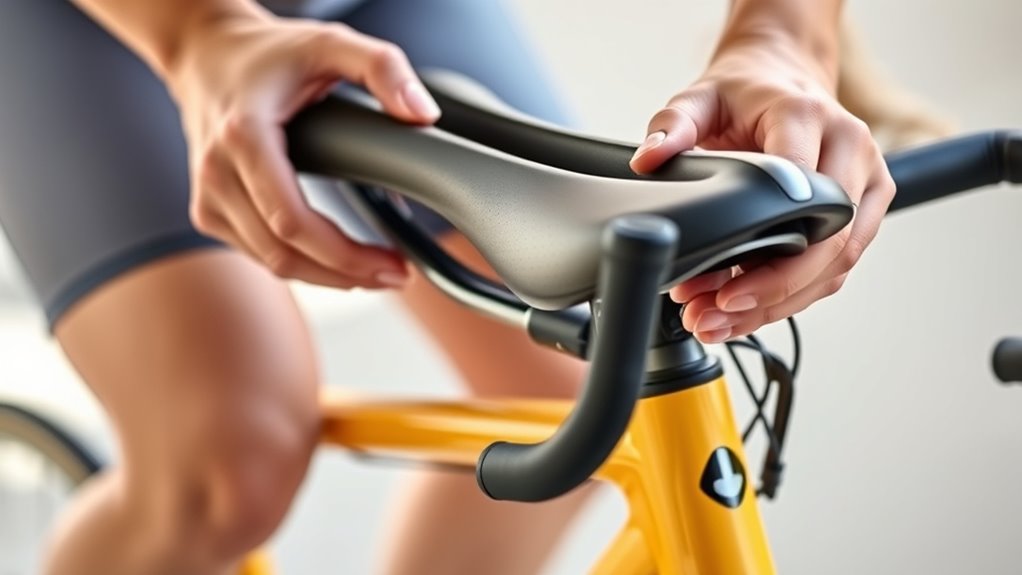
Choosing the right saddle is essential for maximizing comfort and support on your bike, especially since women’s anatomical differences demand a personalized approach.
Selecting the perfect saddle ensures comfort and support tailored to women’s unique anatomy.
To find the best fit, measure your sit bones—this helps determine the ideal saddle width, as women generally need wider seats to reduce pressure. Sit bone measurement is a simple way to identify the most suitable saddle size, ensuring comfort during rides. Additionally, understanding bike fit principles can help optimize overall riding posture and reduce discomfort.
Look for saddles with cutouts or channels to lessen pressure on soft tissues and improve blood flow. Ergonomic designs with proper padding and breathable materials offer additional comfort, especially on long rides.
Ensuring your saddle fits well can also help prevent discomfort or injury during rides, promoting a more enjoyable experience. Incorporating a self-watering plant pot analogy can highlight the importance of proper support and moisture management, emphasizing how tailored solutions improve overall well-being.
Testing multiple options is key; many brands provide trial periods or return policies to ensure a proper fit.
Consulting a bike shop or reading reviews from other women can guide your choice, making sure your saddle supports your body and riding style.
Optimizing Handlebar and Stem Configurations for Better Control
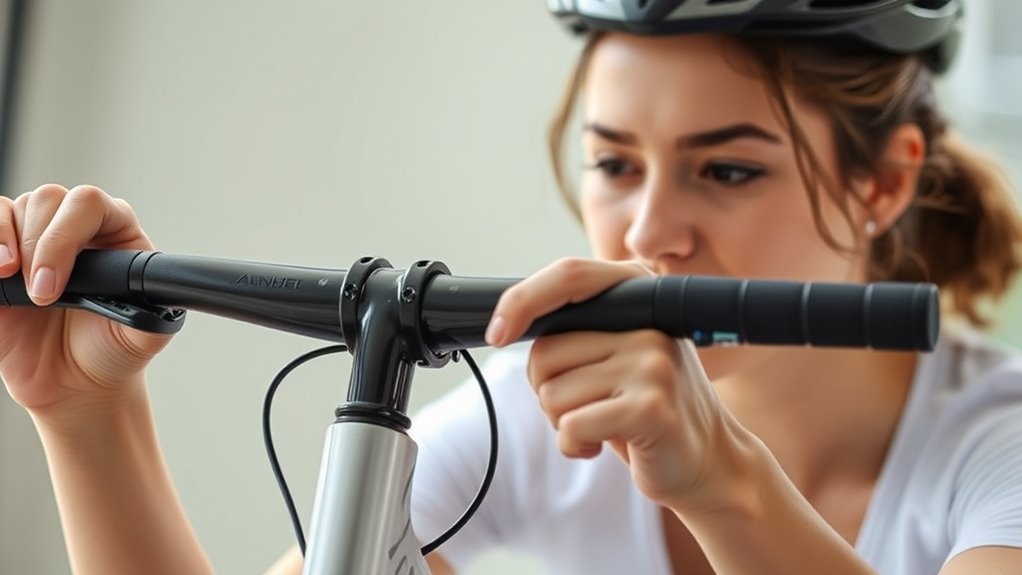
Optimizing handlebar and stem configurations is essential for achieving better control and comfort on your bike. Start by selecting a handlebar width that matches your shoulder width plus 2-4cm to enhance breathing and handling. Narrower bars improve responsiveness but may compromise stability, while wider bars offer upper-body control and open the chest for better airflow. For mountain biking, consider adding 2-5cm to the width for technical terrain. Adjust your stem length to reduce strain—shorter stems (70-90mm) suit smaller torsos, while longer ones extend reach. Fine-tune the angle to elevate or lower the bars, improving posture and handling. Test different lengths and angles to find the setup where your hands reach the hoods comfortably without shoulder rounding or elbow hyperextension. Regularly assessing and adjusting your setup can prevent discomfort and improve overall riding experience and promote proper ergonomics. Additionally, understanding the importance of ergonomic bike fit can help you make informed adjustments tailored to your body. Paying attention to handlebar ergonomics can further enhance comfort and control during your rides. Incorporating scientific research on bike fitting can also guide you toward optimal adjustments for your individual needs. Properly customizing your handlebar and stem setup ensures a comfortable riding position that minimizes fatigue and maximizes performance.
Choosing Appropriate Crank Lengths for Pedaling Efficiency

Selecting the right crank length is essential for maximizing pedaling efficiency and comfort, especially since it directly influences your biomechanics during a ride. To find the ideal length, consider your leg length and inseam, with formulas like 20% of your leg length or 41% of your tibia length. Many women have inseams under 82 cm, meaning standard cranks—usually 170-175 mm—may be too long. Shorter cranks, around 155-165 mm, often improve efficiency and reduce hip flexion, especially for shorter riders. Using tools like the Martin & Spirduso or Graham Obree methods can help estimate the best fit. Remember, the goal is to avoid strain, enhance power, and improve comfort, so trial and professional guidance are highly recommended. Proper cost and budgeting considerations can also help you choose options that fit your needs and finances.
Adjusting Bike Geometry to Match Female Anatomical Needs
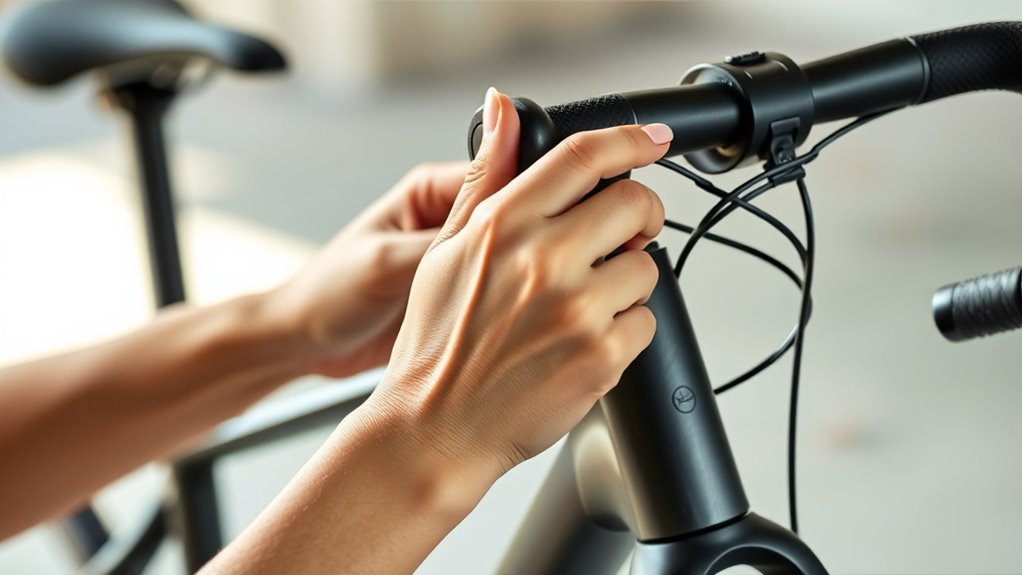
Adjusting your bike’s geometry can markedly improve comfort and performance by better aligning with female anatomical features. You might consider a shorter top tube to accommodate a shorter torso and arm span, reducing strain and enhancing control.
A taller head tube can promote a more upright position, easing neck and back tension. Lower standover height allows easier mounting and dismounting, especially given differences in leg length.
Fine-tune the seat tube angle and length to optimize hip and leg alignment, ensuring efficient pedaling. Adjusting stack height can also lessen neck and back strain.
These modifications help create a bike that fits your body shape, making rides more comfortable and efficient. Proper geometry adjustments are essential for addressing the unique ergonomic needs of women.
The Role of Professional Bike Fitting in Enhancing Performance

Professional bike fitting plays a crucial role in enhancing your cycling performance by ensuring your bike setup aligns perfectly with your body’s unique anatomy and riding style. Using advanced tools like 3D motion capture, this process analyzes your dynamic movements to optimize efficiency and prevent injuries.
Biomechanical assessments evaluate joint angles, pedal stroke mechanics, and muscle activation to boost power transfer. Through iterative adjustments—saddle position, handlebar reach, and cleat placement—you refine your posture and alignment.
For women, custom protocols address specific anatomical traits like shorter torsos and narrower shoulders.
Integration of physical therapy principles helps manage pre-existing injuries and muscle imbalances.
Ergonomic Accessories Tailored for Women Cyclists
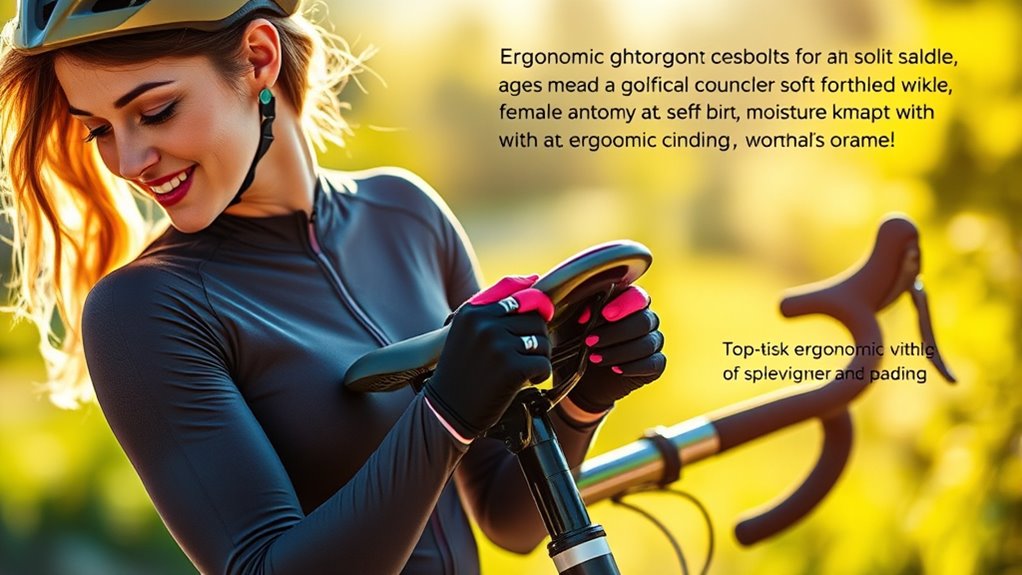
To maximize comfort and performance, women cyclists benefit from ergonomic accessories specifically designed to match their unique anatomical features. Women-specific saddles, like Ergon SR and Spiderflex seats, provide optimized pressure relief and accommodate pelvic structure, reducing numbness and soft tissue compression during long rides.
Women-specific saddles like Ergon SR and Spiderflex provide tailored pressure relief and pelvic support for comfortable long rides.
Cycling apparel with anatomical fits, such as compression shorts with ergonomic seams and jerseys tailored for shorter torsos, prevent chafing and improve comfort.
Handlebar adjustments, including narrower diameters and shorter-reach brake levers, enhance control and fit smaller hands.
Women-specific shoes with narrower heels and metatarsal support ensure better power transfer and knee alignment.
Additionally, maintenance tools like compact multi-tools and lightweight pumps are designed for smaller hands and bike geometries, making routine adjustments easier and more efficient.
Addressing Hip Rotation and Spinal Curvature in Bike Positioning
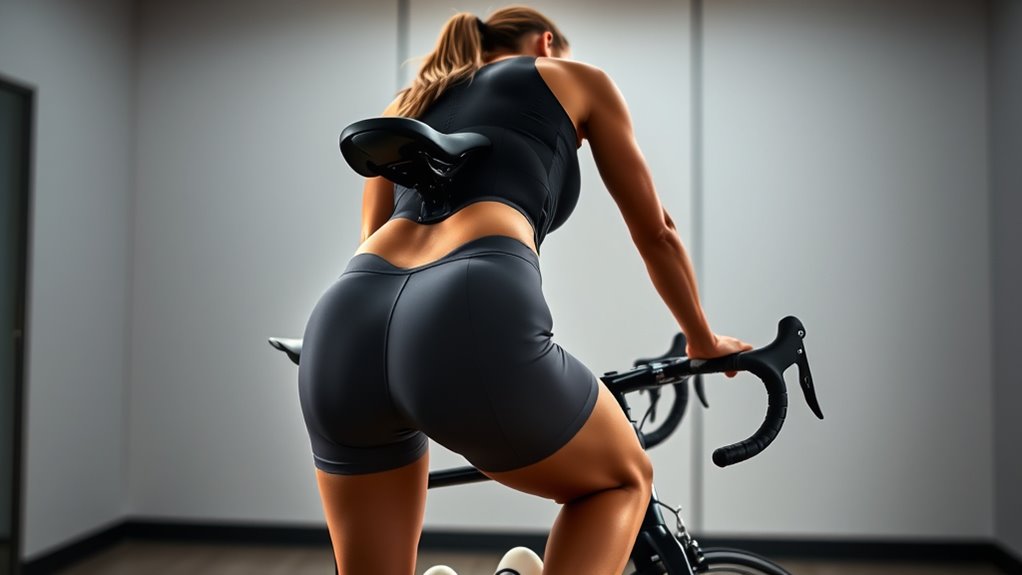
Understanding hip rotation and spinal curvature is essential for optimizing your bike fit and riding comfort. Proper hip rotation ensures efficient power transfer and engages your core muscles, reducing strain on your hands and back.
Under-rotation can cause a vertical posture, choppy pedal strokes, and discomfort. Conversely, over-rotation leads to excessive pressure on the saddle’s front and poor core engagement.
Women’s wider hips and spinal differences, like a more concave lumbar curve and less convex thoracic curvature, influence how you should position yourself. Adjusting saddle height, tilt, and handlebar reach helps accommodate these anatomical features.
Consulting a professional fitter can fine-tune your bike setup, ensuring your hips and spine remain aligned, comfortable, and optimized for efficient, pain-free cycling.
Ensuring Proper Pedal Alignment and Knee Over Pedal Spindle
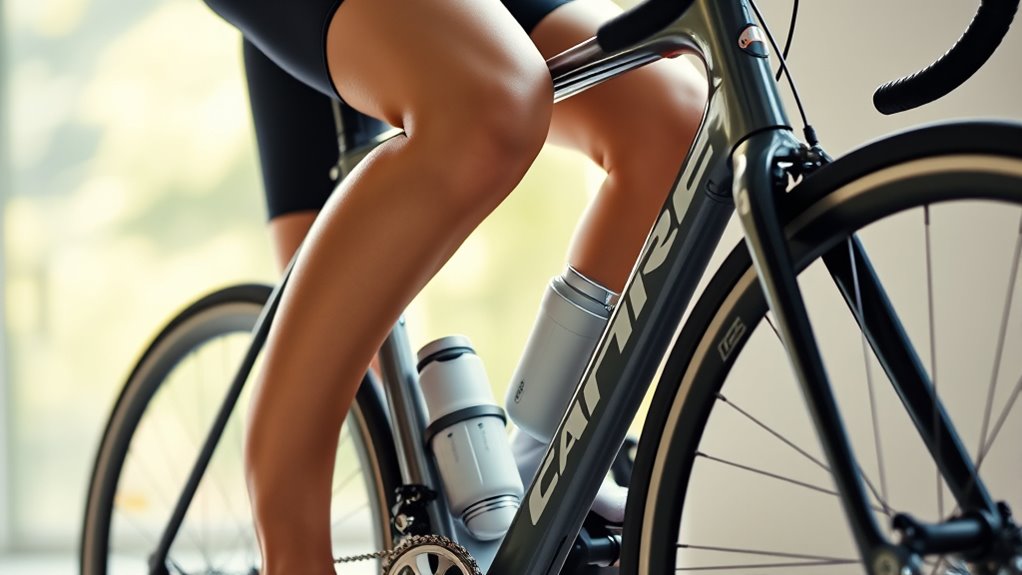
Ensuring proper pedal alignment and knee over the pedal spindle (KOPS) is essential for a comfortable and efficient ride. You want your knee positioned directly over the pedal spindle during the pedal stroke, which helps prevent strain and enhances power transfer.
Adjust your saddle fore and aft to achieve correct KOPS alignment, as saddle position substantially influences knee placement. Be mindful that saddle height impacts knee angle; too high or low can misalign your knee.
Proper crank arm length—often shorter for women—also improves pedal alignment. Additionally, your ankle should maintain about 10 to 15 degrees during pedaling.
Balancing weight over the bottom bracket and considering frame geometry further ensure your knee stays properly aligned, reducing discomfort and increasing efficiency on every ride.
Customizing Bike Fit for Different Cycling Styles and Terrains
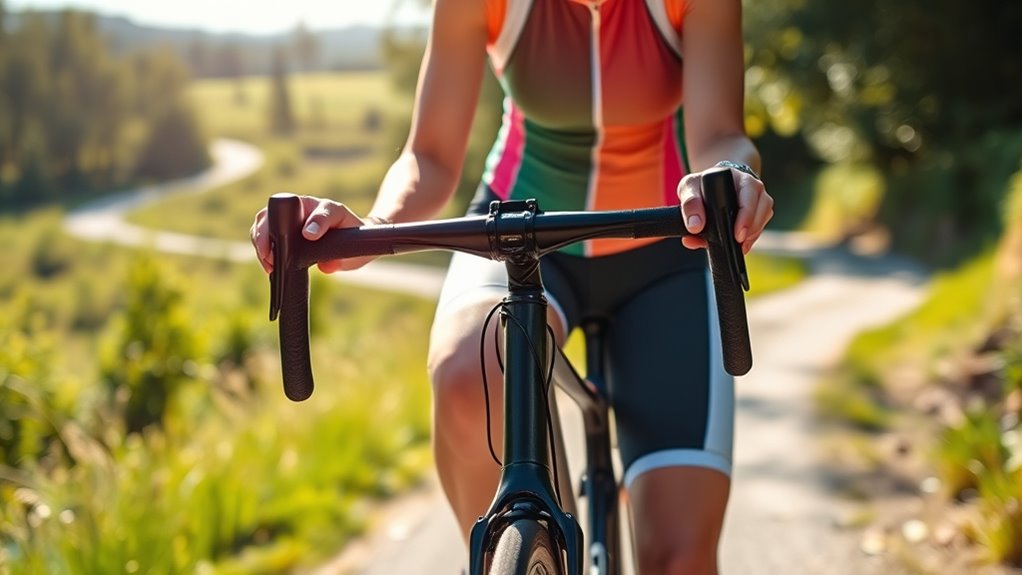
Adjusting your bike fit to match different cycling styles and terrains can substantially enhance comfort, efficiency, and control.
For road cycling, ensure your saddle width matches your sit bone distance to reduce pressure, and set your handlebar height for a slight elbow bend, which improves comfort. Choose a stem length between 80mm and 110mm to optimize your upper body position, and select gearing suited to terrain to maintain a steady cadence. Proper cleat alignment guarantees efficient pedaling and prevents discomfort.
When mountain biking, adjust your seat post height for power transfer, and modify saddle position and bar width to suit technical sections.
For commuting or touring, adopt an upright posture with higher handlebars, and select tires and brakes that enhance safety and handling.
Tailoring your bike fit to your riding style maximizes your performance and enjoyment.
Frequently Asked Questions
How Can I Determine the Ideal Saddle Width for My Pelvis?
To find your ideal saddle width, start by measuring your sit bone distance using one of the methods like the foil or cardboard technique. Ensure you’re sitting upright on a hard surface with thin clothing.
Add the recommended 20mm to that measurement for a comfortable fit.
Keep your posture straight during measurement, and consider your riding style to choose the right width, whether for casual or performance cycling.
What Are Signs My Bike Fit Isn’t Suitable for My Body?
If your bike fit isn’t right, you’ll notice discomfort or pain. Look for saddle soreness, numbness, or chafing, especially in sensitive areas.
You might feel hand or wrist pain from too much weight on the bars, or neck and shoulder tension from poor handlebar positioning.
Knee, hip, or foot pain also signals misalignment.
Persistent fatigue, restricted breathing, or uneven pedal strokes are clear signs your fit needs adjustment.
How Often Should I Reassess My Bike Fit as I Progress?
You should reassess your bike fit regularly as you progress to guarantee ideal comfort and performance. Typically, check it every 3,000 to 5,000 miles or after 6-8 weeks of adopting a new position.
Keep an eye out for discomfort, numbness, or power drops, and adjust after significant physical changes like injury recovery, weight fluctuations, or training milestones.
Regular evaluations help prevent injury and maintain efficiency.
Can Ergonomic Accessories Improve Comfort on Long Rides?
Ergonomic accessories can substantially boost your comfort on long rides. They help by properly supporting your body, reducing pressure points, and improving posture.
Features like ergonomic saddles, pedals, and grips distribute pressure more evenly, lessen fatigue, and prevent pain.
When you choose high-quality, tailored accessories, you’ll enjoy enhanced stability, control, and overall riding pleasure, making those long-distance adventures more enjoyable and less tiring.
How Do I Adjust My Bike for Different Terrains or Cycling Styles?
Imagine your bike as a versatile chameleon, ready to adapt to any terrain or style. To do so, tweak your saddle height for efficiency, adjust handlebar angles for control, and change tire pressure for comfort or speed.
On rough trails, shift your weight and soften suspension. For sprints, lower your handlebar and tighten gears.
These small adjustments transform your ride into a tailored adventure, no matter where you pedal.
Conclusion
Understanding and adjusting your bike to fit your female anatomy isn’t just about comfort—it’s about performance too. Did you know women are 20% more likely to experience overuse injuries if their bike isn’t properly fitted? By addressing ergonomic needs, selecting the right components, and customizing your setup, you’ll ride more efficiently and enjoy every mile. Invest in a proper fit, and you’ll notice the difference in both comfort and confidence on every ride.
